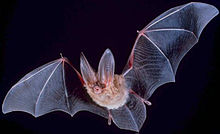- Townsend's big-eared bat
-
Townsend's Big-Eared Bat 
Conservation status Scientific classification Kingdom: Animalia Phylum: Chordata Order: Chiroptera Family: Vespertilionidae Genus: Corynorhinus Species: C. townsendii Binomial name Corynorhinus (Plecotus) townsendii
Cooper, 1837Townsend's Big-Eared Bat (Corynorhinus townsendii) is a species of vesper bat in the Vespertilionidae family.
Contents
Description
The Townsend's Big-Eared Bat is a medium-sized bat with extremely long, flexible ears (hence the name) and small yet noticeable lumps on each side of the snout. Its upperparts are similar to dark brown on the back, and wood-brown on the sides. The underparts are a slightly paler shade of brown. These bats can be identified by the nearly uniform color of their bodies. Its total length is around 10 cm (4 in.), its tail being around 5 cm (2 in.) It's wingspan is about 28 cm (11 in.) It weighs around 7–12 grams.[2] While many other North American bat species are being affected by White Nose Syndrome, as of February 2011 no bats of this species seem to be affected. Researchers are further investigating.
Diet
The Townsend Big-Eared Bat's diet may include small moths, flies, lacewings, dung beetles, sawflies, and other small insects.[2] One report states that the species feeds almost exclusively on Lepidoptera moths.[3]
Range
C. townsendii can be found in the following countries: Canada, Mexico, and United States.[1] This bat is often distributed near rocky areas where caves or abandoned mine tunnels are available. They may also occasionally inhabit old buildings.[2]
Reproduction
The mating season for the Townsend's Big-Eared Bat takes place in late fall. As with many animal species, courtship rituals are done by the male. Until spring, when ovulation and fertilization begin, the female stores the male's sperm in her reproductive tract. Gestation lasts from 50 to 60 days. When the pup is born, it is pink, naked, and helpless. Only one pup is birthed per female, although 90% of females give birth.[4]
Life
The average lifespan of a Townsend's Big-Eared Bat is 16 years.[5]
During summer, males and females occupy separate roosting sites. Males live a solitary lifestyle away from females. Females and their pups form maternity colonies which often number from around 12 to 200, although in the eastern United States colonies of 1,000 or more have been formed.[2]
During the winter these bats hibernate, often when temperatures are around 32 and 53°F (around 0°C and 11.5°C.) Hibernation occurs in tightly packed clusters, which could possibly help stabilize body temperature against the cold. Males often hibernate in warmer places than females and are more easily aroused and active in winter than females. The bats are often interrupted from their sleep because they tend to wake up frequently and move around in the cave or move from one cave entirely to another. Before hibernation, C. townsendii increase their body mass to compensate for the food they do not eat during the winter.[2]
Taxonomy
Members of the genus Corynorhinus were previously in the genus Plecotus.
Subspecies
Four subspecies exist:
- C. t. townsendii
- C. t. ingens Ozark Big-Eared Bat (Federally endangered[6])
- C. t. virginianus, the Virginia big-eared bat (Federally endangered[7] the Virginia state bat)
References
- ^ a b Arroyo-Cabrales, J. & Ticul Alvarez Castaneda, S. (2008). "Corynorhinus townsendii". IUCN Red List of Threatened Species. Version 2009.2. International Union for Conservation of Nature. http://www.iucnredlist.org/apps/redlist/details/17598. Retrieved 2010-01-25.
- ^ a b c d e Townsend's Big-eared Bat (Plecotus townsendii). Nsrl.ttu.edu. Retrieved on 2010-11-05.
- ^ Dobkin, David S. (1995), Radiotelemetry Study of Townsend's Big-Eared Bat (Plecotus townsendii) on the Fort Rock Ranger District, Deschutes National Forest, Central Oregon, p. 35
- ^ Townsend's Big-eared Bat – Colorado Division of Wildlife. Wildlife.state.co.us (2009-07-27). Retrieved on 2010-11-05.
- ^ Ministry of Environment – Okanagan Region – Townsend's Big-eared Bat. Env.gov.bc.ca. Retrieved on 2010-11-05.
- ^ Ozark Big-Eared Bats, Ozark Big-Eared Bat Pictures, Ozark Big-Eared Bat Facts – National Geographic. Animals.nationalgeographic.com. Retrieved on 2010-11-05.
- ^ Virginia big-eared bat. Biology.eku.edu. Retrieved on 2010-11-05.

This Vespertilionidae article is a stub. You can help Wikipedia by expanding it.


